To meet the increasingly stringent quality and control requirements of the aerospace and aeronautical industry, long-standing supplier Merletti recently installed a painting system designed and built by Eurotherm with advanced technical solutions for climate control, filtration, and continuous monitoring of process parameters. With this strategic choice, it completed the vertical integration of its production process, further strengthening its position in a rapidly growing sector.
“The only way of discovering the limits of the possible is to venture a little way past them into the impossible.”
Arthur C. Clarke in ‘Profiles of the Future’, 1962
Space exploration has always held a powerful fascination for collective imagination, fuelled by the innate human curiosity to push the boundaries of our fantasy beyond the confines of Earth. But to overcome those limits and achieve the ‘impossible’, as Arthur C. Clarke wrote in one of his famous essays, we need technologically advanced machines and devices – the result of in-depth engineering studies that precede the construction of precision mechanical components, be they small or large, certified to guarantee maximum strength and durability.
Behind every orbit traced, every observation mission, and every functioning satellite, there is a solid industrial supply chain operating on the ground to enable the (as yet few) lucky ones to venture beyond the sky: this is the aerospace industry, in which Italy is a leading player at the international level. In 2024, this sector generated a turnover of €18 billion, contributing approximately €8 billion to exports and employing almost 60,000 people [1]. Such steady growth reflects the ability of the aerospace and defence sector to integrate technological innovation, production specialisation, and strategic vision, factors that have led Italy to rank fourth in Europe and seventh in the world [2].
From design to production, from defence to Earth observation, Italy’s aerospace industry is composed of a network made up of 80% small and medium-sized enterprises, supported by large contractors such as Leonardo, Thales Alenia Space Italia, Avio Aero, and Telespazio. This cohesive ecosystem participates in all major international programmes, such as Galileo, Copernicus, and Sustainable Aviation, giving shape to complex technologies capable of operating in extreme environments.
It is in this context that the technological know-how of a company specialising in precision machining and part assembly for over fifty years comes into play: Merletti Srl (Arsago Seprio, Varese, Italy) is a firm of excellence at the heart of this supply chain, where attention to detail, continuous evolution, and the vertical integration of processes translate into solutions ready to meet any space and defence-related need. “Founded in 1972 by Gianluigi Merletti and his wife Narcisa as a company operating in the contract precision mechanics sector for the aeronautical, aerospace, and defence industries,” says Administration and Finance Controller Ivan Zingaro while illustrating the company’s history, “Merletti Aerospace is now run by the family’s second generation, represented by the founder’s children Sabrina and Ruggero, who serve as the company’s CEOs as well as Technical Director and Sales & Quality Director, respectively. Under their guidance, we have increasingly specialised in the aeronautical, aerospace, and defence industries, combining a policy of internationalisation with a focus on the vertical integration of our production structure, which we completed recently by installing a painting plant supplied by Eurotherm (Volpiano, Turin, Italy), a company designing and constructing plant solutions for a wide range of sectors, particularly aerospace.
Complying with high quality standards
“In a highly regulated industry such as ours,” adds Zingaro, “compliance with the most stringent quality and safety standards is crucial for operating and growing internationally. Merletti Aerospace embarked on this path back in 1995 by obtaining ISO 9001 certification, integrated in 2006 with the specific industry standard AS/EN 9100, which qualifies companies to supply products and services in the aeronautical, aerospace, and defence sectors. In 2018, we achieved a further milestone by obtaining approval under European regulation PART 21G, which enables us to manufacture aeronautical components with direct airworthiness, thus joining the list of Production Organisation Approvals (POA) by both EASA (European Union Aviation Safety Agency) and ENAC (Italian Civil Aviation Authority). In addition, in Italy, we have been granted the TULPS licence under Article 28, issued by the Prefecture for the manufacture and management of material intended for armament and defence. Finally, Merletti Aerospace is a member of AIAD (Italian Companies for Aerospace, Defence, and Security) and has been an active member of the Lombardy Aerospace Cluster since its foundation in 2009, an integrated system of companies, universities, and research centres that has become one of the most advanced technological hubs in the sector at the national level.”
Certifying excellence in aerospace
Merletti Aerospace’s objectives revolve around continuous quality and organisational improvement, with a focus on both internal efficiency and the consolidation of relationships with leading national and international prime contractors in the fixed and rotary-wing segments, in the civil, military, and defence sectors, and increasingly, in the underwater industry, where there is growing demand for specialised components and systems. “With this in mind,” says Zingaro, “Merletti Aerospace has gradually expanded its production capacity, developing a comprehensive vertical integration strategy that culminated in the creation of a second business unit in Somma Lombardo, just a few kilometres from the first. This new site handles our key special processes, such as non-destructive testing with penetrating liquids, magnetoscopic testing, and painting with an innovative plant designed to meet the new requirements of our target markets.”
The creation of this new business unit in Somma Lombardo, and in particular the commissioning of non-destructive testing equipment, enabled the company to obtain the prestigious NADCAP certification for surface treatments, an international credential that certifies the compliance of special processes with the most stringent requirements of major contractors in the sector. Indeed, Merletti Aerospace has embarked on a multi-year investment programme that has led to it obtaining important recognition. Thanks to targeted actions aimed at the complete digitalisation of its processes in line with Industry 4.0, it has also become a Confindustria Showcase Factory this year, a recognition awarded to a few cutting-edge Italian companies that have integrated advanced and visible production solutions into their plants. “We are proud to be the only company in our industry to have been awarded this title,” Zingaro confirms with satisfaction.
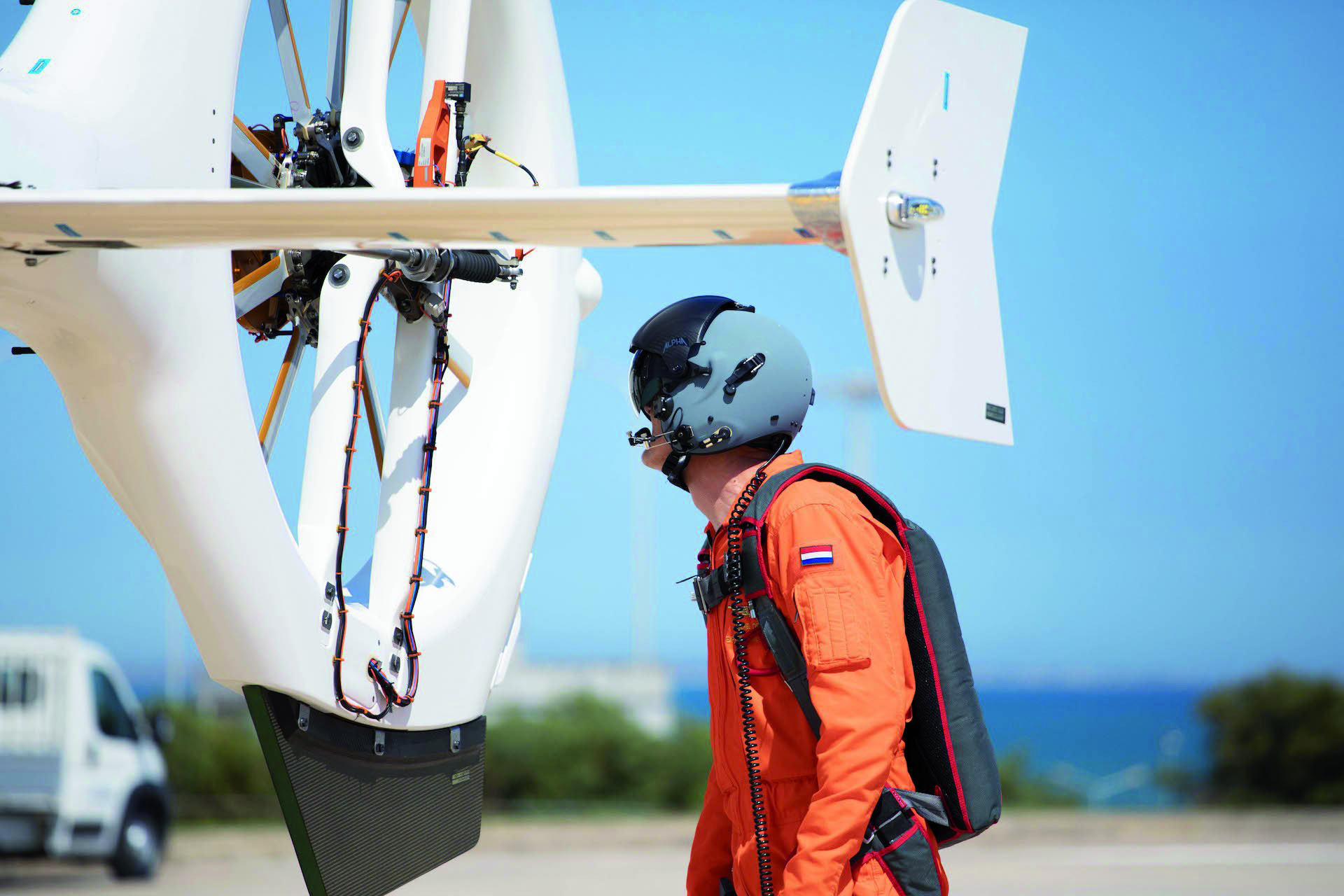 In the rotary-wing sector, Merletti has achieved excellence in the machining of critical and complex parts in various alloys, as well as in the manufacture of assemblies for rotors, transmissions, and other structural parts. Ⓒ Leonardo Spa
In the rotary-wing sector, Merletti has achieved excellence in the machining of critical and complex parts in various alloys, as well as in the manufacture of assemblies for rotors, transmissions, and other structural parts. Ⓒ Leonardo SpaA 100% vertically integrated production process
“Every stage of our production process takes place in-house. Design authority, i.e. the final technical responsibility for the design of a component, lies with the customer; our staff is responsible for its production development, starting with the study of the equipment we need to integrate into our machinery to process the part most effectively and efficiently, thus reducing lead times.”
The production department is equipped with machining centres capable of treating components that call for a high degree of precision and finishing quality and for materials with excellent mechanical characteristics: aluminium, high-strength steel, titanium, and Inconel. The production flow is monitored in real time through the management software and barcode-based data collection solution, which is fully integrated into the ERP management system in accordance with Industry 4.0 interconnection parameters.
After processing in advanced machining centres, the components undergo a degreasing phase in four tanks, the required galvanic treatments, and coating with a solvent-based or water-based polyurethane or epoxy paint product, depending on the specifications.
“In our production cycle, the painting process, which usually follows galvanic treatments, is the last operation before final checks,” explains Andrea Scrosati, Painting Plant Project Manager at Merletti Aerospace. “After galvanic deposition, only specific types of material, such as precipitation hardening steels and austenitic steels, undergo chemical pre-treatment, whereas all other components are subjected to mechanical deburring. The components also undergo a masking phase to ensure further protection against corrosion and aggressive agents, as well as the best aesthetics. The painting phase follows with the application of two coats of organic film (epoxy or water-based primer + epoxy or polyurethane top coat).
“Any flaws in their application can lead to a significant increase in maintenance costs and, in the most serious cases, compromise the integrity of the part. In the aeronautical field, depending on the OEM, coating can be classified as a ‘special process’ or a ‘critical process’, proving that it is a production phase requiring careful management, as well as records and checks in accordance with the specifications. In addition to a reliable system capable of guaranteeing repeatable results, the training, education, and qualification of our personnel through theoretical and practical courses tailored to provide a thorough understanding of the coating processes and products, which vary according to the materials to be treated, have been fundamental in meeting all our requirements.”
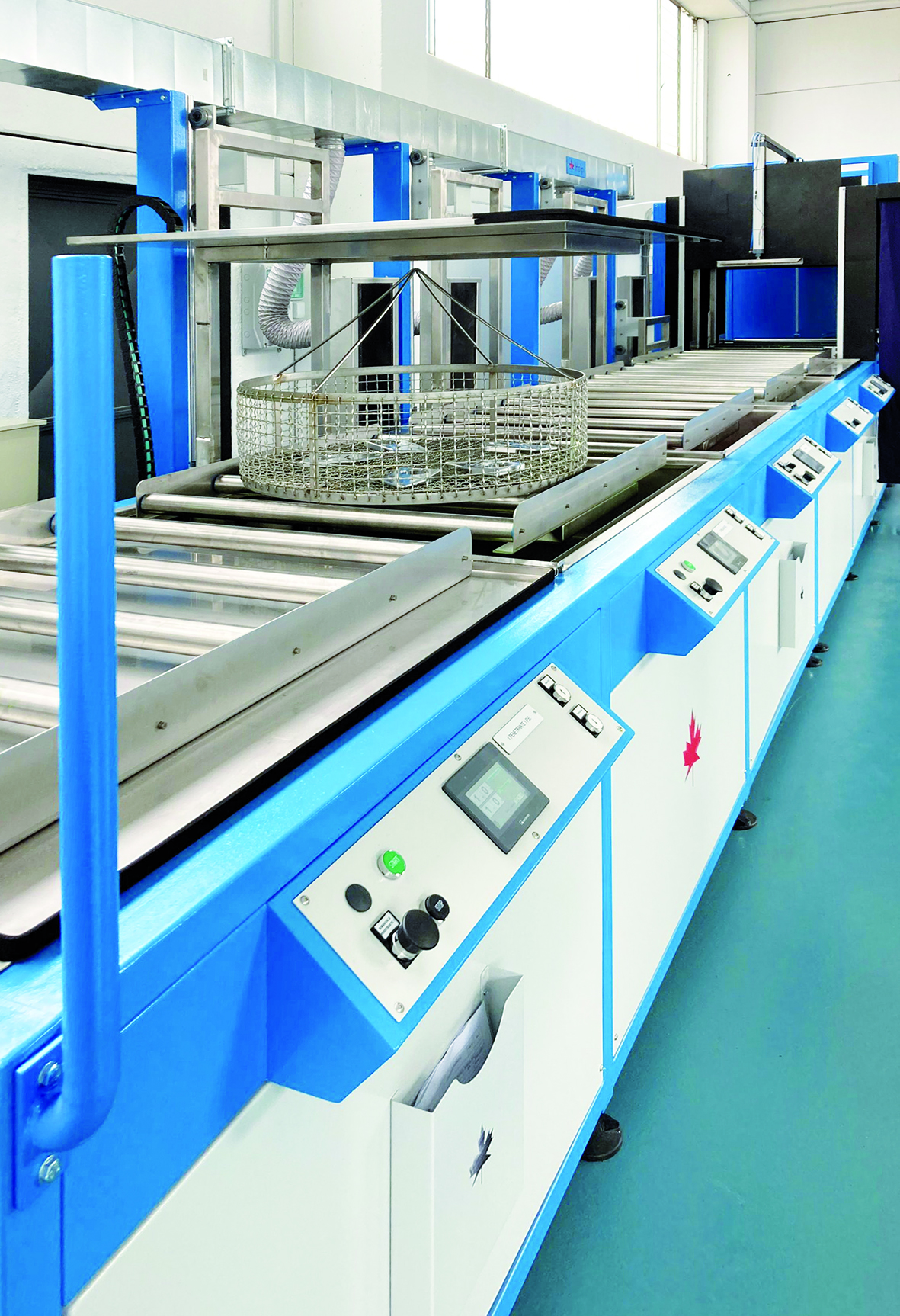 The degreasing system with four tanks for degreasing, rinsing, drying, and cooling. Ⓒ Merletti Srl (se verticale) Ⓒ ipcm (se orizzontale)
The degreasing system with four tanks for degreasing, rinsing, drying, and cooling. Ⓒ Merletti Srl (se verticale) Ⓒ ipcm (se orizzontale)In addition to completing its vertical integration process, insourcing the coating phase has enabled this company to achieve strategic objectives such as reducing lead times, lowering logistics costs, and gaining greater control over operational continuity. “We carried out a careful analysis of the most advanced plant solutions on the market, aiming to equip ourselves with a system that was environmentally friendly and, at the same time, able to comply with the stringent requirements imposed by our sector,” says Scrosati. “Ultimately, we selected a supplier that could ensure full availability and flexibility in supporting the setup of the solution best suited to our needs and guarantee the use of highly advanced materials, equipment, and control systems. Another essential requirement for us was that the supplier’s entire team had solid know-how in the aerospace field. The choice thus fell on Eurotherm, the ideal partner for this project.”
A system designed specifically for the aerospace industry
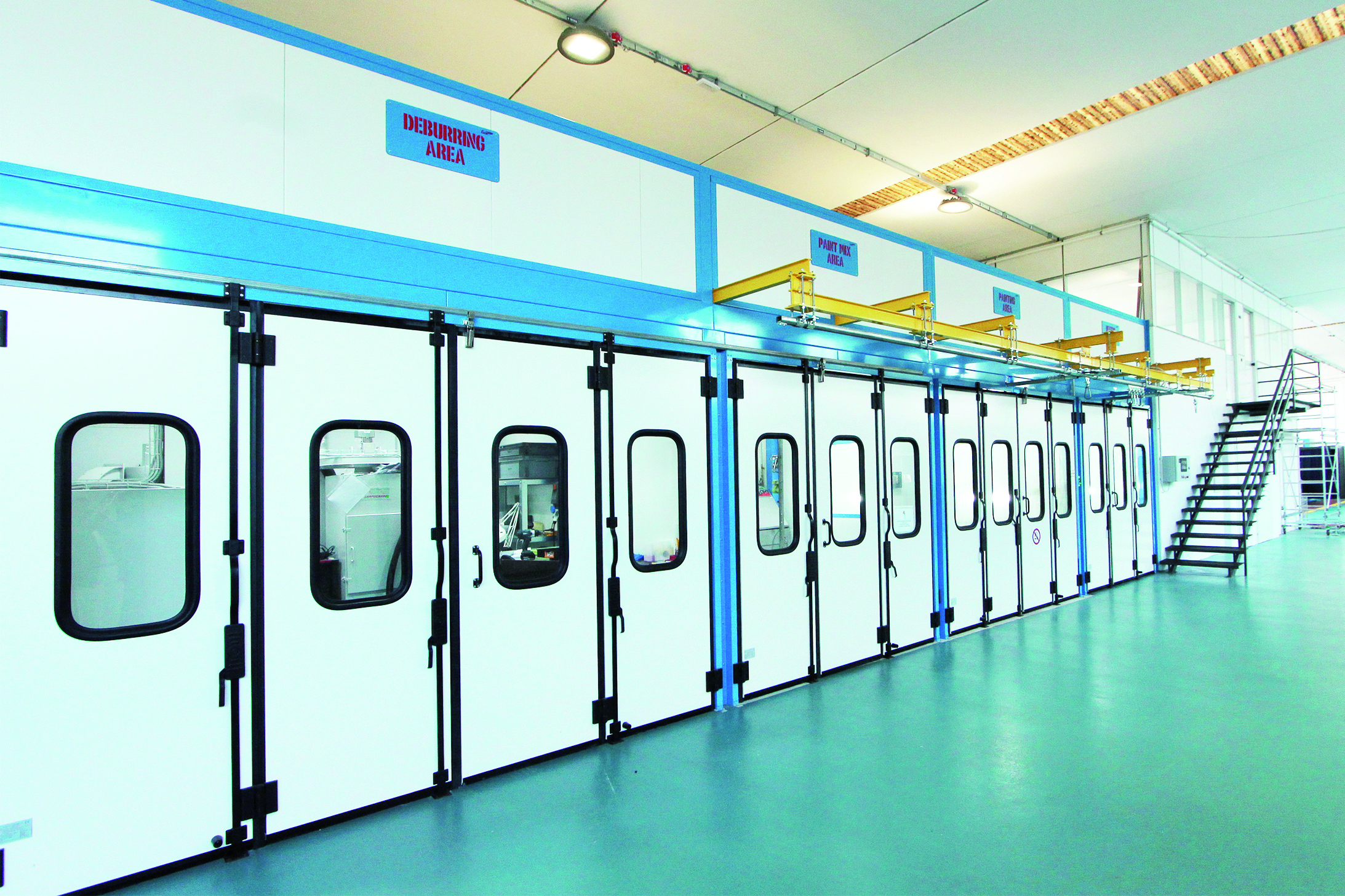 The painting plant designed and installed by Eurotherm. Ⓒ ipcm
The painting plant designed and installed by Eurotherm. Ⓒ ipcmThe system designed and installed by Eurotherm consists of four adjacent booths for deburring, paint mixing, liquid coating, and drying. These are served by an external trolley handling system designed to prevent surface contamination during the transfer of parts among the different stations (see the Box for technical details).
In addition to this, other plant solutions have been adopted at the specific request of Merletti Aerospace, including air conditioning of the coating booth with a dry filtration unit, controlled air flow, and an internal temperature of 19 to 26 °C. This configuration not only guarantees ideal conditions for paint application but also contributes to the operators’ comfort by avoiding exposure to high (and therefore sub-optimal) temperatures.
“The introduction of air from the ceiling, combined with floor extraction, generates a downward flow that helps precisely control the speed and direction of the air at the operator’s height, significantly reducing the risk of air pollution and part contamination,” explains Scrosati. “The air conditioning system maintains the temperature between 19 and 26 °C and the relative humidity between 35% and 75%, regardless of external conditions. This is an unusual configuration, a truly distinctive feature of our plant that provides high stability of process parameters. The same technological approach has also been adopted for the drying oven, whose temperature can reach 80 °C but is likewise kept uniform (+/- 5÷6 °C) and controlled by thermocouples.
To ensure that environmental conditions are maintained at all times, the plant is also equipped with sensors that monitor temperature and humidity values every two minutes. The data collected is managed by dedicated software that automatically sends email notifications to the operators in charge in the event of anomalies. “The investment in this sensor system was considerable, but the solution we chose guarantees that optimal operating conditions are maintained at all times, with direct benefits for the quality of our process and the safety of our employees.”
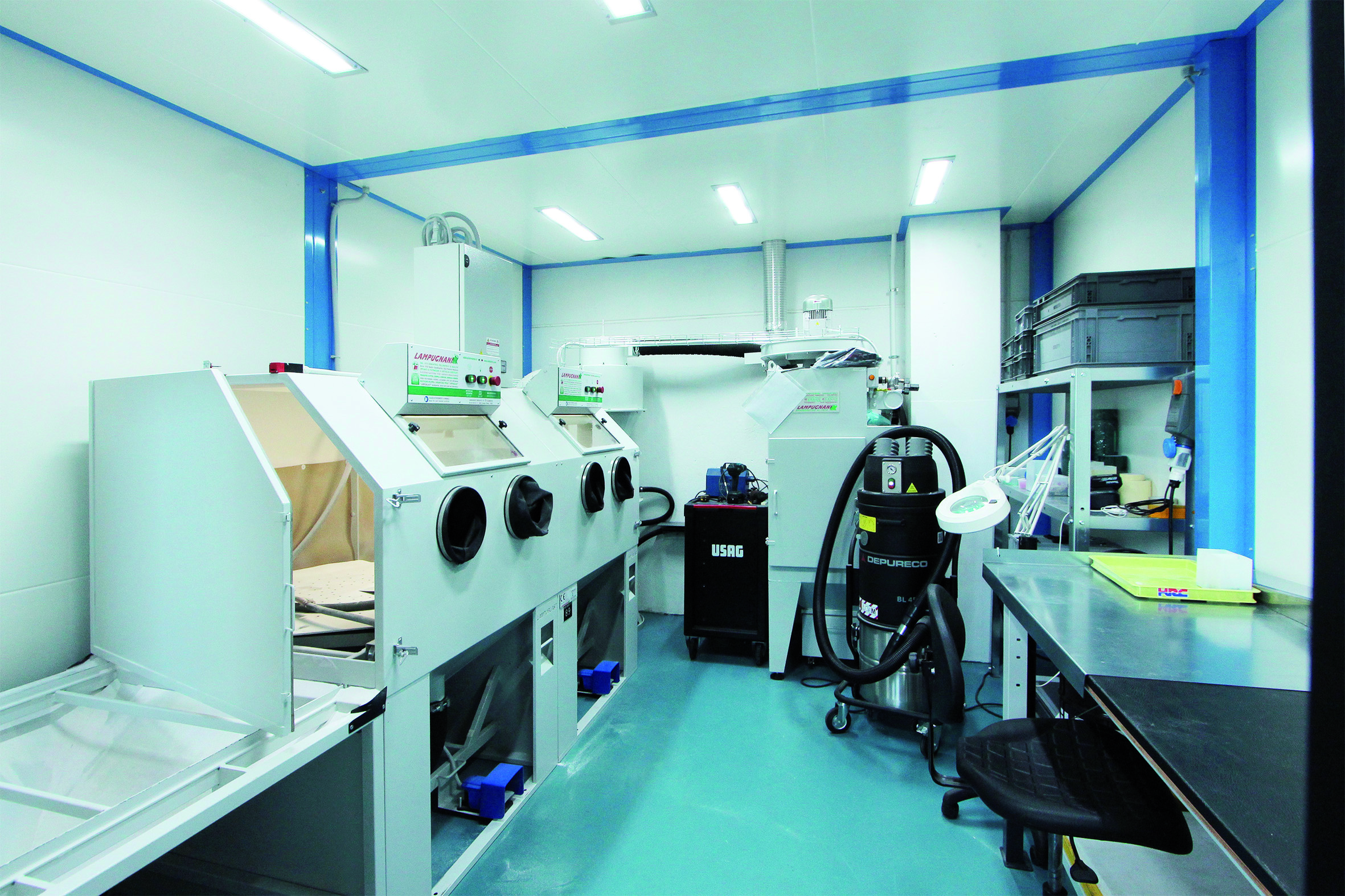 The first booth, devoted to deburring operations. Ⓒ ipcm
The first booth, devoted to deburring operations. Ⓒ ipcm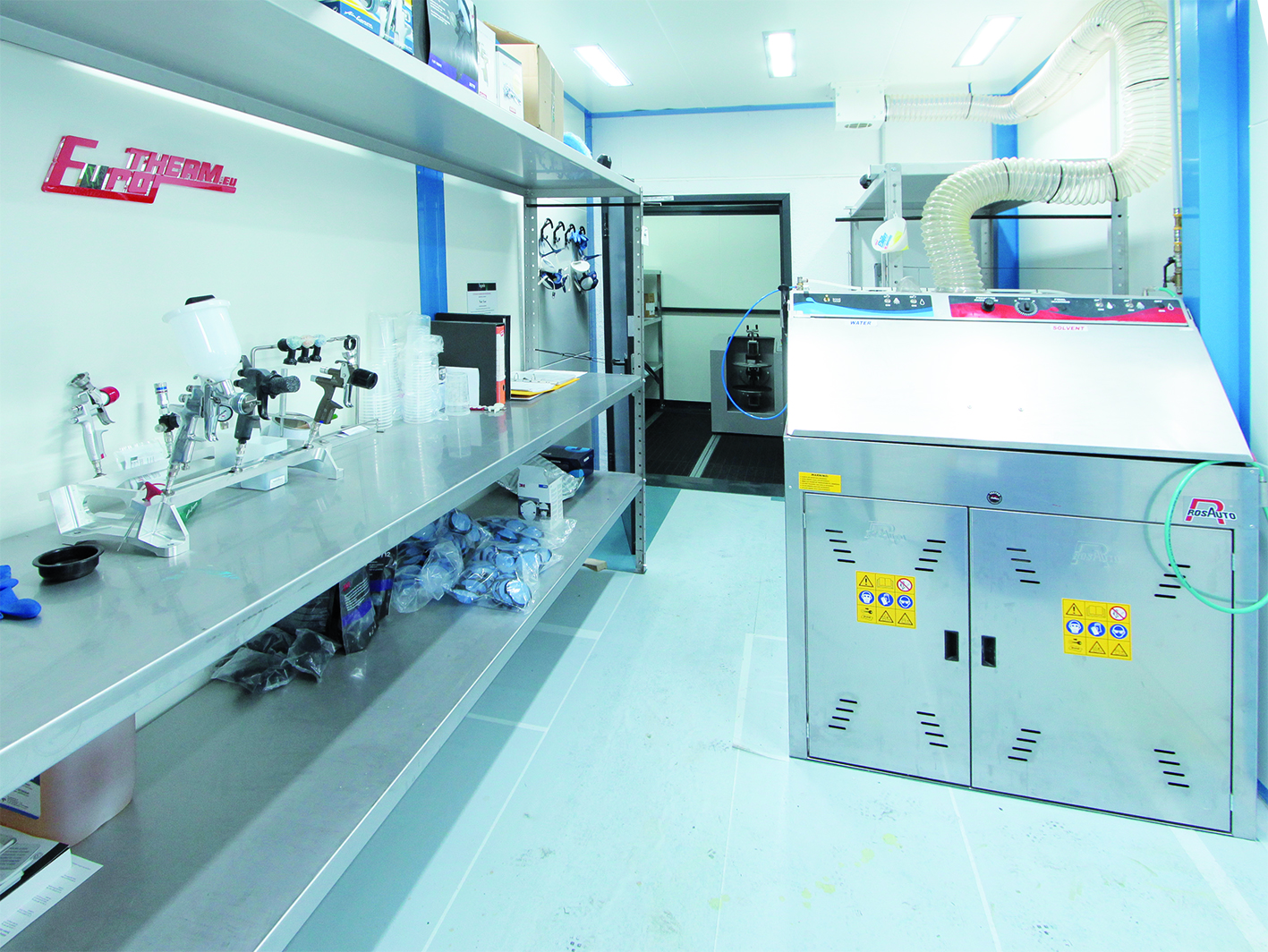 The booth for paint mixing. Ⓒ ipcm
The booth for paint mixing. Ⓒ ipcm“If the requirements are high, we achieve the impossible”
This new plant marked a turning point for Merletti Aerospace, enabling it to make a qualitative leap forward in an extremely challenging sector, having already consolidated its ability to comply with the highest mechanical standards. Even without direct comparison with previous in-house experiences, the advantages brought by this line are already apparent. “In addition to the total absence of dust inside the booths, guaranteed by the advanced filtration system and optimised air flow management, which has eliminated the risk of contamination thus improving both product quality and the healthiness of the work environment, I would also like to highlight the ergonomic and user-friendly features of the system, which were the result of careful, user-oriented research, as well as the completely remote monitoring of parameters,” emphasises Scrosati. Application consistency, process repeatability, and parameter stability ensure full compliance with the highest standards required by the aerospace industry. Additionally, the plant offers strategic advantages in terms of sustainability, thanks to the low energy consumption characteristics that strengthen the company’s environmental commitment.
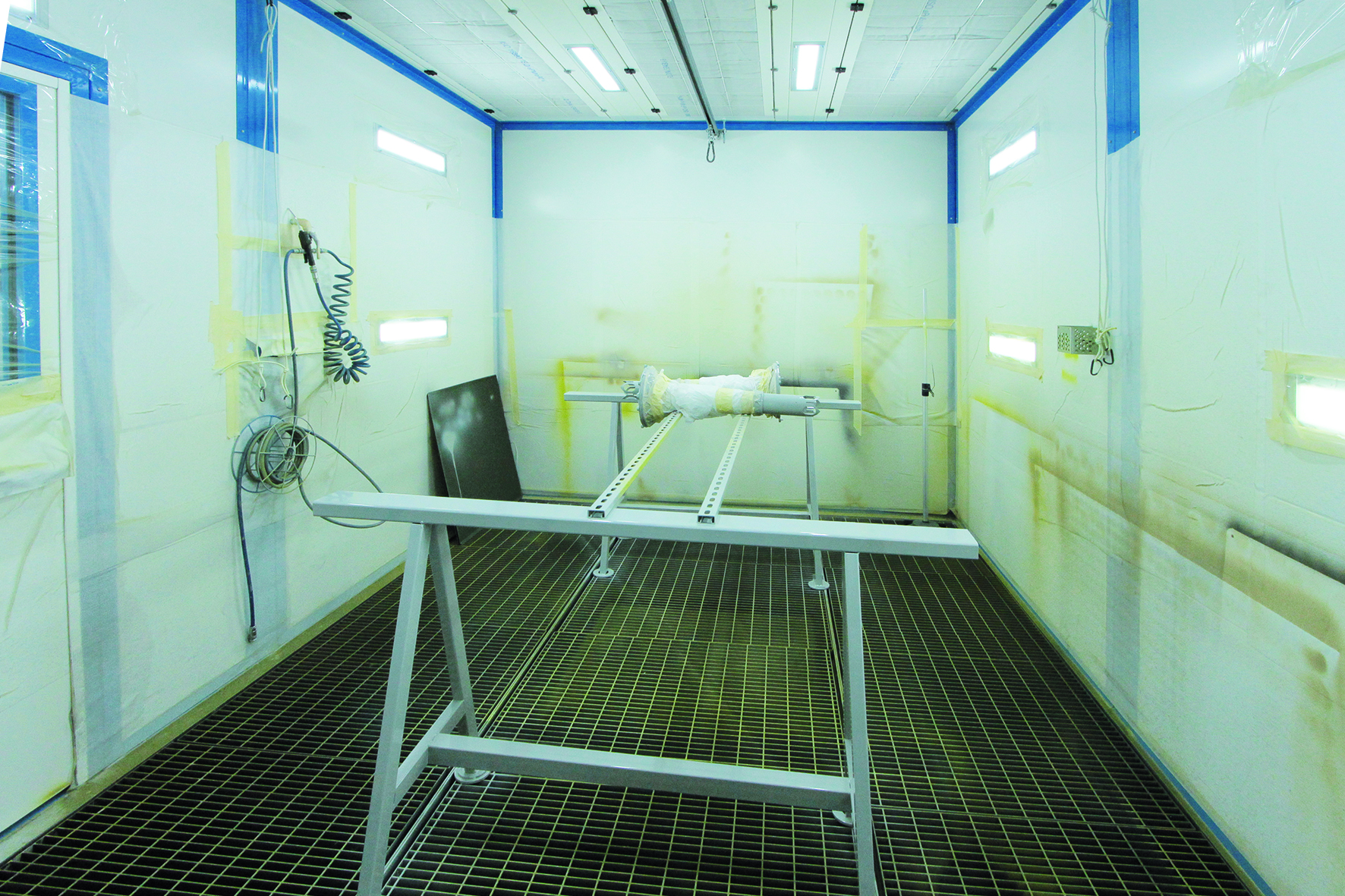 The liquid painting booth. Ⓒ ipcm
The liquid painting booth. Ⓒ ipcm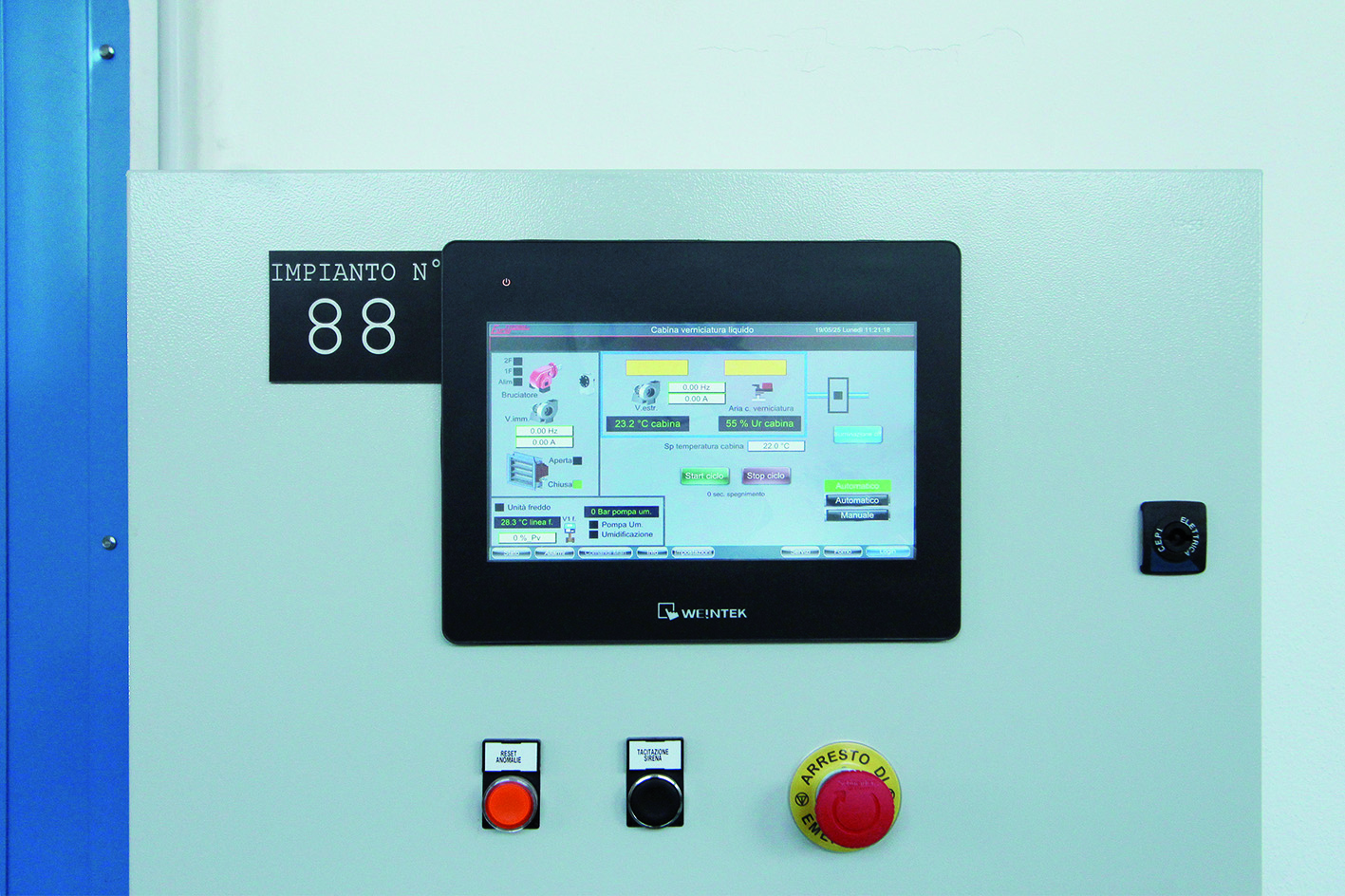 The control display of the painting booth. Ⓒ ipcm
The control display of the painting booth. Ⓒ ipcm“In the Eurotherm team, we have found the attention to detail, build quality, and care for materials that are also our core values,” concludes Zingaro. In a constantly growing industry where significant global investment is expected in the coming years and where scientific research is paving the way for a future in which space will be increasingly accessible to all, Merletti is ready to meet – and exceed – ever-more extreme requirements, raising the bar ever higher, beyond the possible... to achieve the impossible.
 In the aeronautical and aerospace industry, the prime contractors’ specifications impose increasingly stringent compliance requirements. Ⓒ Leonardo Spa
In the aeronautical and aerospace industry, the prime contractors’ specifications impose increasingly stringent compliance requirements. Ⓒ Leonardo SpaTechnical characteristics of the painting plant
The liquid painting plant installed by Eurotherm at Merletti’s site consists of four adjacent booths separated by folding doors and connected by an overhead conveyor consisting of sliding guides and mechanical/pneumatic switches, which allow moving the workpiece-carrying trolleys manually along the route and positioning them in the various operating stations.
The loading/unloading area also serves as a storage buffer. The system features an AHU for air conditioning and an air-conditioned module for paint storage, equipped with a containment tank following legal requirements.
The four main units, described below, are arranged adjacent to each other, forming a line with a length of 10.5 m, a depth of 4 m, and a maximum height of 3 m.
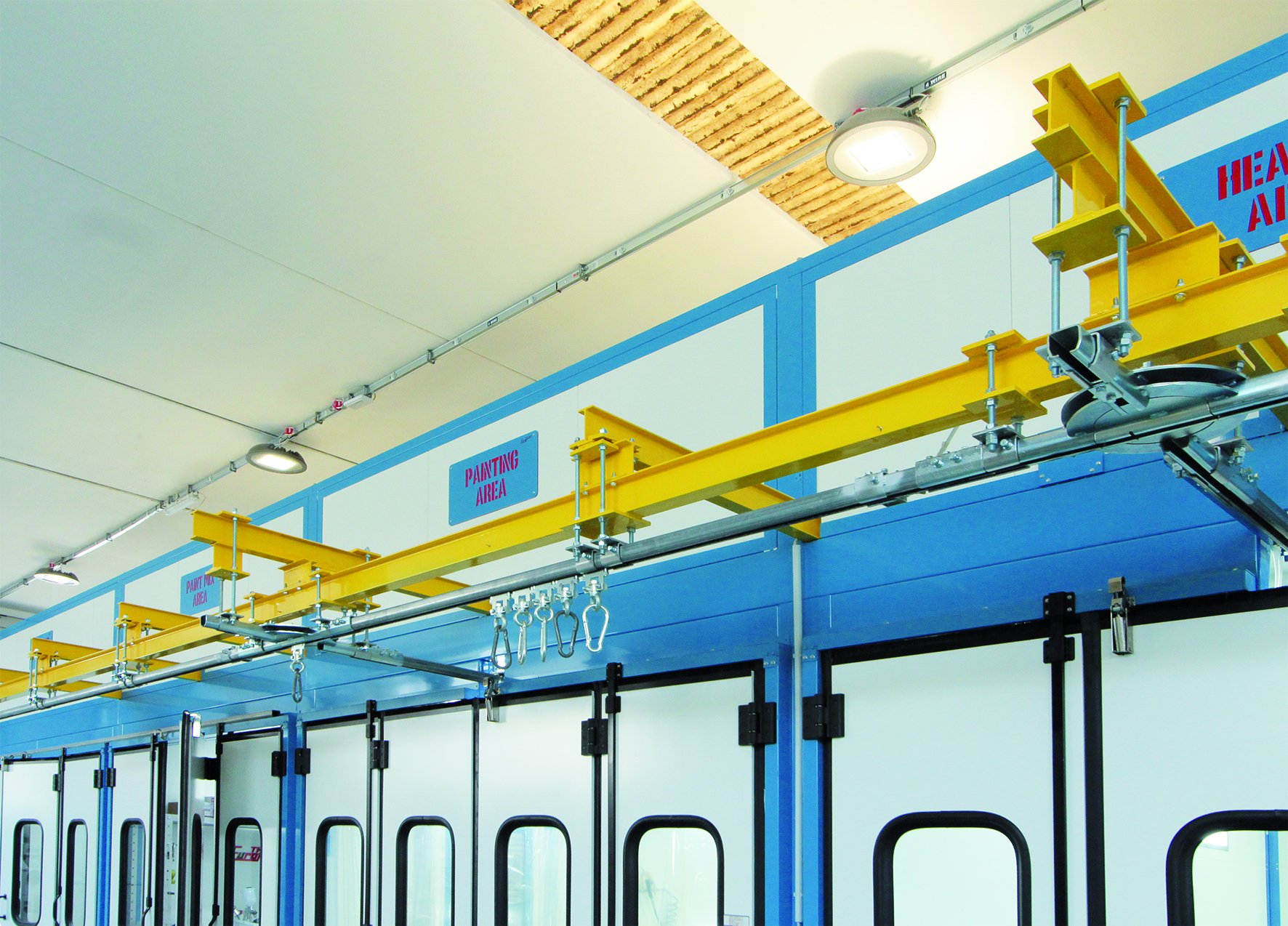 The external overhead conveyor consisting of sliding guides and mechanical/pneumatic switches, which allow the workpiece-carrying trolleys to be moved manually along the route.
The external overhead conveyor consisting of sliding guides and mechanical/pneumatic switches, which allow the workpiece-carrying trolleys to be moved manually along the route.1. Deburring booth
Formed by a self-supporting structure made of steel profiles and 50 mm-thick walls insulated with mineral wool, it is equipped with a 2000x800 mm workbench and an Atex-certified extractor fan with filtration efficiency up to 1 µm.
2. Technical room
Built like the previous booth, it is equipped with a mixer, a sink with a stainless steel top for cleaning the guns, an ATEX LED ceiling light, and a fan for extracting vapours.
3. Pressurised liquid painting booth
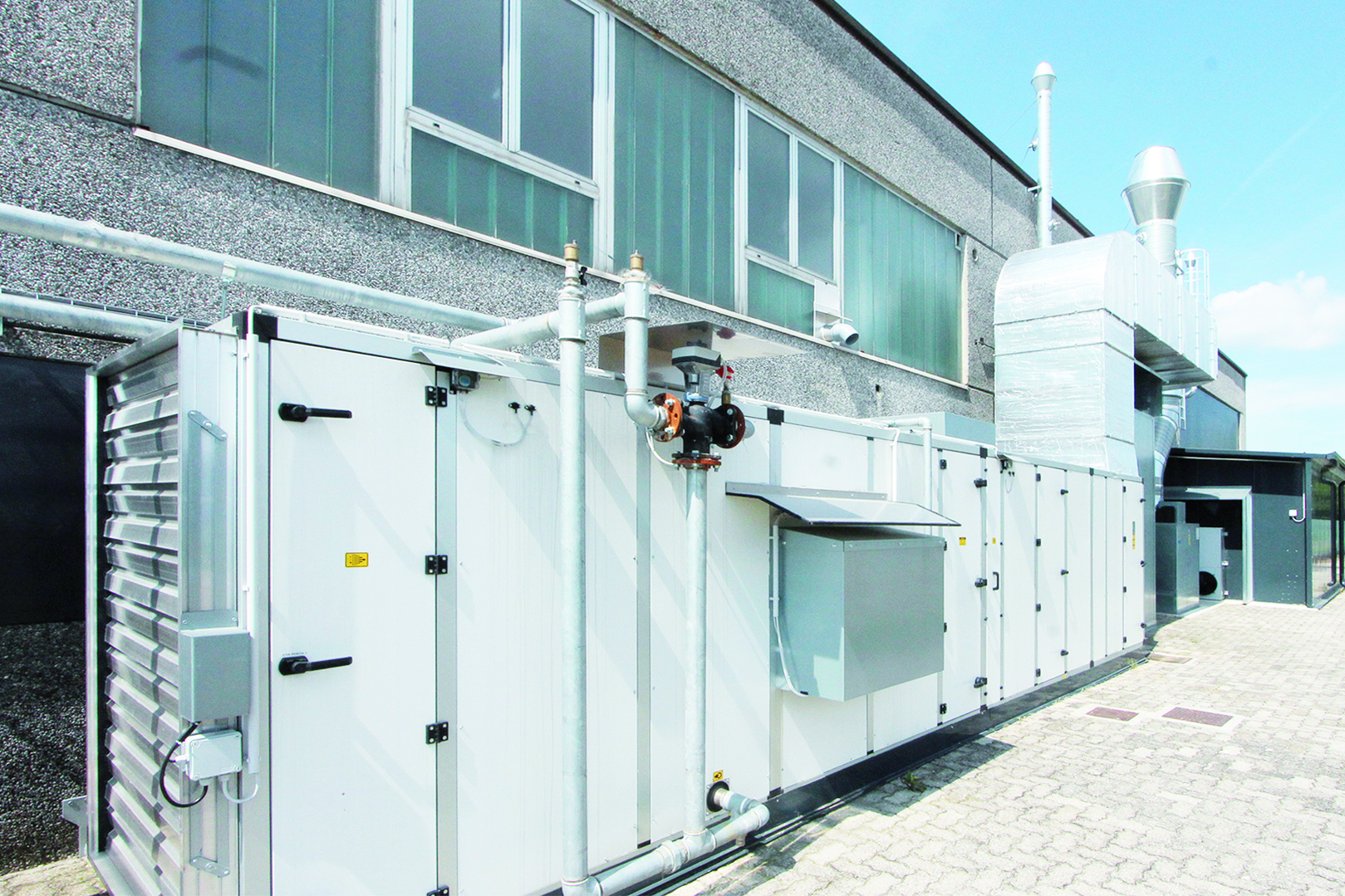 The AHU installed outside the factory.
The AHU installed outside the factory.This booth’s body also consists of a load-bearing structure made of electro-welded steel profiles covered with pre-painted, galvanised, double-sheet panels with a high-density rock wool insulation system (80÷100 Kg/m3), with a total thickness of 50 mm. The air flow is balanced by an air intake AHU located externally and connected to the air intake plenum space through galvanised ducts. The overspray extraction pit is only 800 mm deep and is closed at the top by a pedestrian grating with a load capacity of 800 Kg/m2.
The booth’s operating principle is simple and effective. The overspray is conveyed through the extraction unit to the floor filters (Table 1).
Table 1: Technical characteristics of the filtration system
Air flow rate
|
23,000 m3/h
|
Air velocity in the booth
|
~0.5 m/s
|
Air intake AHU power
|
15 kW (adjustable via an inverter)
|
Extraction unit
|
9.25 kW (adjustable via an inverter)
|
Temperature and humidity
The air conditioning system can maintain a temperature between 19 and 26 °C and a relative humidity between 35 and 75% inside the booth, regardless of the external weather conditions.
Lighting
Lighting inside the painting cell has a value of 900 lux measured at a height of 1.40 cm from the floor (or work surface) to ensure that there are no shadows during the various processing stages.
4. Drying oven
Built like the previous modules, the oven is protected with layers of high-density rock wool (100 kg/m3) with a thickness of 80 mm to optimise insulation and provide an effective barrier against heat loss (Table 2).
Table 2: Technical characteristics of the drying oven
Voltage
|
3x400 V+N+E
|
Heat source
|
Gas burner
|
Operating temperature
|
60 – 80 °C
|
Temperature uniformity
|
+/- 5 °C
|
Probe accuracy
|
+/- 1 °C
|
Time to reach the set temperature
|
30 – 40 min
|
Installed thermal power
|
65 kW
|
Recirculated air flow rate
|
5,000 m3/h
|
Air changes
|
200 per hour
|
Fan power
|
1 x 2.2 kW
|
Extraction fan power
|
1 x 0.55 kW
|
Monitoring and control system
The entire line is equipped with an advanced supervision system based on a series of sensors that continuously detect the primary process and safety parameters, including the temperature and humidity values inside the painting booth, the operating status of the oven, the efficiency of the ventilation system, and the efficiency of the filters. There are also sensors for controlling the gas burners, the humidification unit, and the electrical and mechanical safety devices. The system is configured to take readings every two minutes and send automatic email notifications to the operators in charge if the set limits are exceeded or in the event of faults.